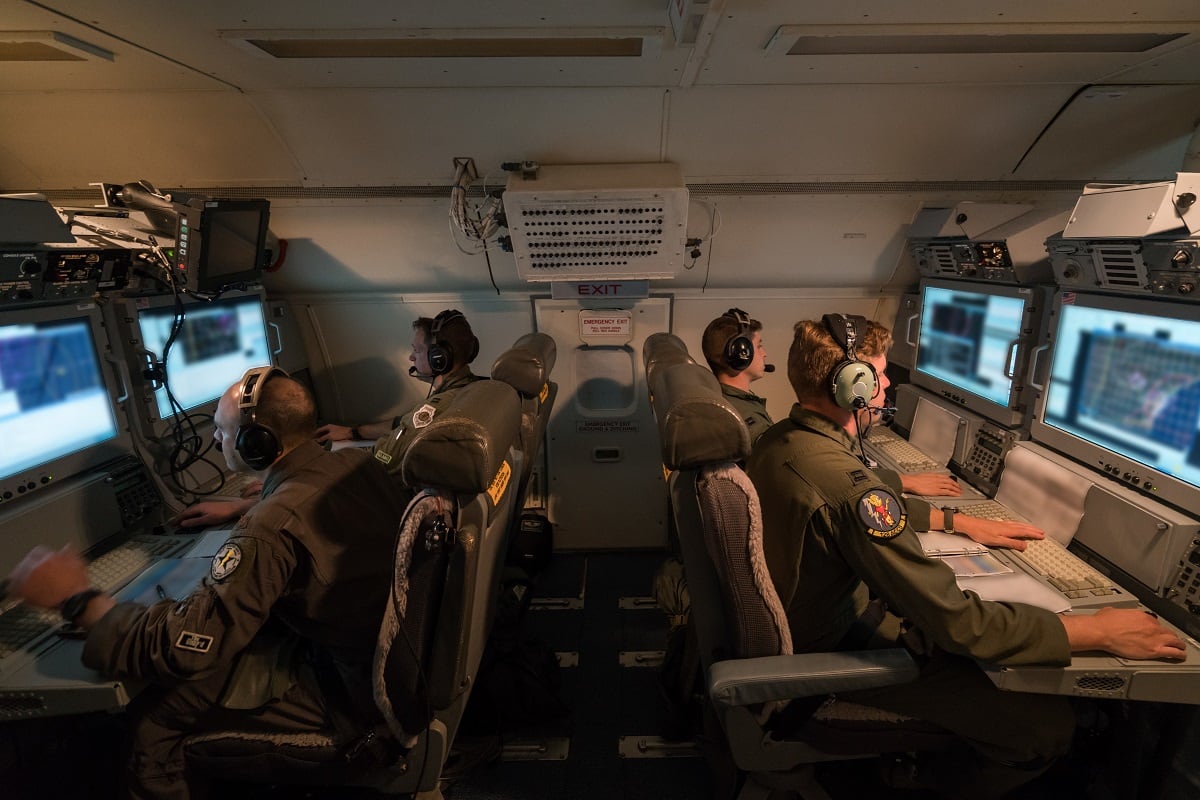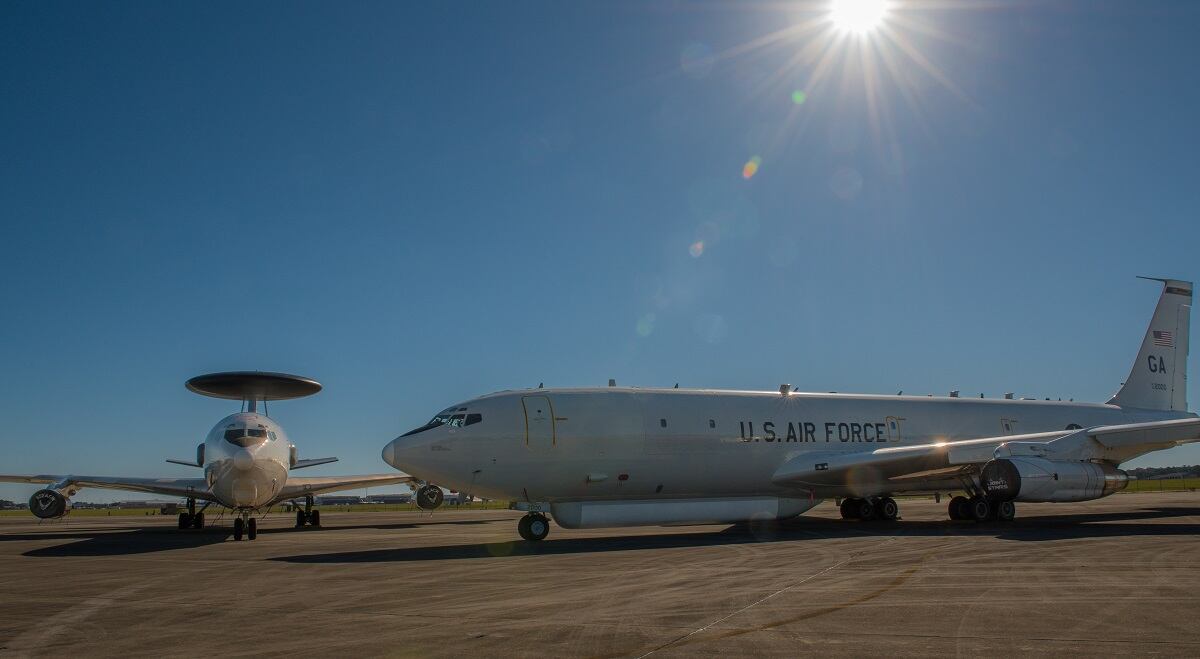LONDON — The Air Force scored a major win in the 2019 defense authorization bill: Not only will it be able to cancel the JSTARS recap program, it is getting additional funds for its alternative effort called Advanced Battle Management System.
However, the service will have to make some concessions in terms of its plans to retire the existing E-8C Joint Surveillance Target Attack Radar System fleet, which is used for ground surveillance and command and control missions.
The Air Force had planned to retire three E-8Cs in 2019 that had become “hangar queens” cannibalized for spare parts for the rest of the fleet, Air Force Secretary Heather Wilson said earlier this year.
RELATED

However, according to the new defense policy bill unveiled Monday, it will not be able to retire any of the 17 planes until “increment 2” of the ABMS system is declared operational, although Congress will allow the Air Force secretary to phase out planes on a case-by-case basis if an aircraft is no longer mission capable.
While the Air Force has not spelled out to the public exactly what comprises its ABMS plan, it involves a host of different upgrades for existing platforms —for instance the MQ-9 Reaper and E-3 AWACS early warning aircraft — that will allow them to network together in new ways.
A congressional aide told Defense News on July 24 that the Air Force have three ABMS increments in a series of classified briefings to members of Congress’ defense committees.
Phase one, which lasts from now until about 2023, involves upgrades to datalinks and some space-based technologies, as well as linking sensors from several stealth platforms and drones together, the aide said.
Increments 2 and 3 quickly get into more classified territory, said the aide, who declined to provide greater specifics.
The defense authorization bill would accelerate ABMS by adding $120 million for six MQ-9 Reapers, which the aide said could be used to help boost the architecture’s ability to prosecute targets during a low-end conflict. It also included $30 million to continue development of the ground moving target indicator radar developed by Northrop Grumman for the JSTARS recap program.
In addition, Congress levied a number of other restrictions and reporting requirements on the Air Force as part of the FY2019 National Defense Authorization Act, including:
- The Air Force’s plan for modernizing and sustaining the current JSTARS fleet, including how it will increase the availability of the E-8Cs to support demands worldwide.
- Quarterly reports from the Air Force secretary on the progress of ABMS.
- Certification by the defense secretary that the Air Force has a long term funding plan that will allow it to retain JSTARS and that the ABMS acquisition strategy is executable.
- A report on ABMS from the Government Accountability Office, which provides independent oversight to Congress. The report will review the maturity of the plan and any risk associated with fielding or funding it.
- A directive to the Pentagon’s Cost Assessment and Program Evaluation office to reexamine the cost and schedule for restarting a re-engine effort of the E-8C, which had begun in 2008 but was since abandoned. The Air Force “procured three ship-sets of engines, after investing $450.0 million, and the engines remain unused,” even though “the legacy E-8C engines are the number one issue driving excessive non-mission capable maintenance metrics for the E-8C fleet,” the bill stated.
The end of the JSTARS recap program is bad news for Lockheed Martin, Boeing and Northrop Grumman, who were each vying for the prime contractor spot and the $6.9 billion contract for engineering, manufacturing and development. A total of 17 new planes were planned to be built throughout the program.
Over the past year, Air Force leaders grew disenchanted with JSTARS recap, saying that new battle management planes would not be survivable in future, contested battlespaces.
But while the Senate defense committees leaned in to support ABMS, House lawmakers sought to force the service to keep going with JSTARS recap.
Will Roper, the Air Force’s top acquisition official, told Defense News on July 17 that he was hopeful that Congress would move forward with ABMS. However, he still acknowledged that the Air Force had never modernized a “system of systems” like ABMS before.
“It definitely needs to be a program where we embrace failure up front and prototype, because there’s going to be a lot of learning to do about how do you make things work together as a team,” Roper said. “We get a sense of how commercial industry is solving it and I imagine we can use a lot of their lessons learned, but probably not all of them.”
Infighting in Georgia
What was once a disagreement between the House and Senate seems to have turned into a fight among the members of the Georgia delegation.
RELATED

In a surprising move, Republican Rep. Austin Scott pointed the finger at Sen. David Perdue, a fellow Georgia Republican, for allowing the recap program to be cancelled. Georgia’s Robins Air Force Base is home to the 116th Air Control Wing that operates JSTARS.
“When Senator Perdue […] withdrew his support of this program which the Georgia Congressional Delegation – including Senator Perdue – has overwhelmingly supported throughout the last seven years, it effectively ended the program,” said Scott.
“Unfortunately […] the replacement aircraft will not be fielded, forcing a higher risk to our men and women in uniform by continuing to fly the 48 year old legacy JSTARS aircraft which are in need of recapitalization.”
Perdue hit back in his own statement, saying that ABMS is a better long term solution for Robins.
“The Advanced Battlefield Management System will give us the capability to access both restricted and non-restricted airspace. This is a necessity in supporting our troops in harm’s way as well as our overall intelligence gathering,” Perdue said. “With the solution I support, we save JSTARS jobs, maintain the JSTARS fleet into the next decade, accelerate the implementation of ABMS, and gain a new mission for Robins. All of this guarantees a very bright future for my hometown base.”
Valerie Insinna is Defense News' air warfare reporter. She previously worked the Navy/congressional beats for Defense Daily, which followed almost three years as a staff writer for National Defense Magazine. Prior to that, she worked as an editorial assistant for the Tokyo Shimbun’s Washington bureau.








